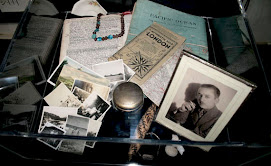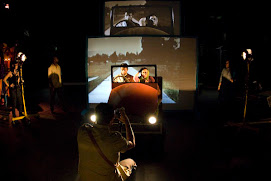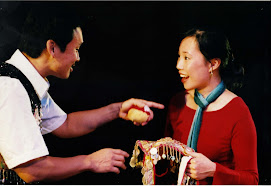Just back from the OzAsia Festival Symposium, and thinking about that whole vexed issue of using economic arguments to justify support for the arts. This was a tension throughout the weekend—and not always an underlying one.
In the last few years the favoured argument seems to be that a robust arts community increases the ‘liveability’ of a city or state, increasing its attractiveness for business investment, thereby providing jobs, et cetera, et cetera. What concerns me is not so much the truth or otherwise of these assertions, but the fact that we’ve jettisoned the language of culture and aesthetics in favour of the language of economic-impact studies—the language of politicians, in other words. And I think this concession, this shift to economic rather than cultural argument, is dangerous.
It’s dangerous because—thanks to widespread cultural illiteracy and a largely debasing mass media—most Australians have no idea why public support for the arts is worthwhile. So even though politicians tell us we’re living in an era of unprecedented (material) prosperity, the arts are starved of vital subsidy, and arts education is sidelined as irrelevant to the New World Economy. Then in a stroke of Orwellian cunning, that lack of appreciation is used as a rationale to continue not funding the arts.
Back to OzAsia, an excellent and much needed initiative, putting a bit of cultural diversity back onto the arts table. A table which—after a brief 1980s/early 90s flirtation with rye and pitta and Vietnamese pork rolls—has reverted to white sliced. (Although I must admit that when I read clunky sentences like: ‘Australian artists that identify with an Asian heritage’ various bells start ringing.) The symposium brought together practitioners, academics, arts administrators and representatives from a range of funding and state and federal organisations. So saying … when governments use the arts to spearhead trade programs or diplomatic initiatives, what companies and kinds of work do they chose to sponsor? Large dance companies, classical music ensembles, circuses? Productions guaranteed to make a big splash. But what about that small group of independent artists developing a more risky or experimental project, or beginning a long-term collaboration? Thank goodness then for Asialink, who seem to understand that professional relationships are built slowly, and that good work, especially that which crosses the boundaries of language and geography, takes time as well as resources.
The highlight of the symposium for me was undoubtedly the keynote paper from Calcutta-based writer, theatre director, cultural critic and independent scholar, Rustom Bharucha. It’s difficult to summarise because of the wide range and complexity of the issues he addressed. But here goes … Drawing on his 2006 book Another Asia, he exposed the capitalist bones of this hugely heterogeneous body called ‘Asia’, queried the word ‘enmeshment’, explored issues of nationalism, exchange, creative process, community, intercultural dreaming—and much, much more. It was passionate and provocative, eloquent and erudite, and I only wish there had been more time to discuss some of the ideas he raised.
Seems appropriate then to end with this favourite quote from Edward Albee: ‘Theatre tells us who we are, and the health of the theatre is determined by how much we want to know.’
26 September 2007
18 September 2007
Writing Korea & Questions of Connection
I’ve been writing UNREQUITED these last couple of weeks. Immersed again in the singular and surreal reality that is North Korea; obsessed with the huge concrete shell of Pyongyang’s unfinished Ryugyong Hotel. Why a reclusive society like the DPRK, with an economy in cardiac arrest, would need a 105-storey, 3,000-room hotel is—well, a mystery. In a country of mysteries.
Also reconnecting with the plugged-in world of the South. Remembering for some reason, the omnipresent fatigue: In a Seoul café a 40-something man nods off, his coffee going cold on the table in front of him. Sprawled on nearby benches, students take a nap. While on the subway, I’d often find myself the only person in the carriage who was awake. Remembering too those conversations I had with people about traditional culture and globalisation. A recollection prompted, I suspect, by reading Nayan Chanda’s Bound Together: How Traders, Preachers, Adventurers, and Warriors Shaped Globalization, which offers more than the usual economic perspectives on this topic.
Anyway, getting ready to present UNREQUITED at the forthcoming OzAsia Festival in Adelaide, I’ve been thinking about questions of tradition, authenticity and that oft-repeated mantra: art is a universal language. Here’s where I’m up to:
Cultural traditions are porous; authenticity, like El Dorado, is a myth. For any tradition to thrive, the old and the new need to engage in a dialogue with each other. And it goes without saying that what constitutes tradition can be difficult to gauge, and even more difficult to agree upon.
I wouldn’t deny the power of art as a universal language, but would suggest that it’s a more complex contention. For example, the only time I can honestly say that I’ve ever connected with Ibsen, was through a production of A Doll’s House performed entirely in Bengali. I’ve lived happily through King Lear in Korean, and a Vietnamese adaptation of the Albert Camus play Le Malentendu gave me real insight not only into local issues specific to Hanoi at the time of the production, but also into the original 1944 context of the work. In all these cases however, what was transmitted were the storylines, themes and moral dilemmas the playwrights wished to communicate, not their manner of conveying it. So I’d venture that substance is what makes art universal; style places it distinctively, and uniquely, in its own culture.
Also reconnecting with the plugged-in world of the South. Remembering for some reason, the omnipresent fatigue: In a Seoul café a 40-something man nods off, his coffee going cold on the table in front of him. Sprawled on nearby benches, students take a nap. While on the subway, I’d often find myself the only person in the carriage who was awake. Remembering too those conversations I had with people about traditional culture and globalisation. A recollection prompted, I suspect, by reading Nayan Chanda’s Bound Together: How Traders, Preachers, Adventurers, and Warriors Shaped Globalization, which offers more than the usual economic perspectives on this topic.
Anyway, getting ready to present UNREQUITED at the forthcoming OzAsia Festival in Adelaide, I’ve been thinking about questions of tradition, authenticity and that oft-repeated mantra: art is a universal language. Here’s where I’m up to:
Cultural traditions are porous; authenticity, like El Dorado, is a myth. For any tradition to thrive, the old and the new need to engage in a dialogue with each other. And it goes without saying that what constitutes tradition can be difficult to gauge, and even more difficult to agree upon.
I wouldn’t deny the power of art as a universal language, but would suggest that it’s a more complex contention. For example, the only time I can honestly say that I’ve ever connected with Ibsen, was through a production of A Doll’s House performed entirely in Bengali. I’ve lived happily through King Lear in Korean, and a Vietnamese adaptation of the Albert Camus play Le Malentendu gave me real insight not only into local issues specific to Hanoi at the time of the production, but also into the original 1944 context of the work. In all these cases however, what was transmitted were the storylines, themes and moral dilemmas the playwrights wished to communicate, not their manner of conveying it. So I’d venture that substance is what makes art universal; style places it distinctively, and uniquely, in its own culture.
Subscribe to:
Posts (Atom)

+Photo+Leah+McGirr+3.jpg)


